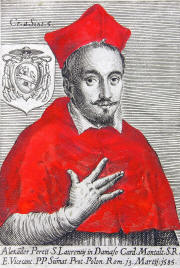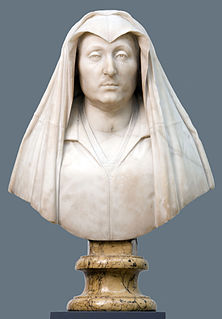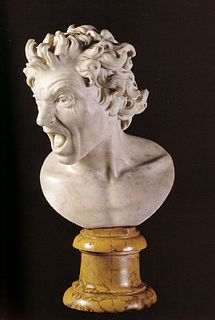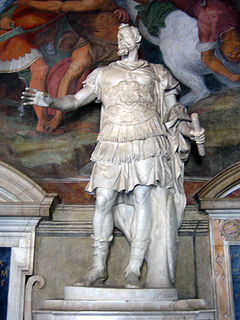
Gian LorenzoBernini was an Italian sculptor and architect. While a major figure in the world of architecture, he was more prominently the leading sculptor of his age, credited with creating the Baroque style of sculpture. As one scholar has commented, "What Shakespeare is to drama, Bernini may be to sculpture: the first pan-European sculptor whose name is instantaneously identifiable with a particular manner and vision, and whose influence was inordinately powerful ..." In addition, he was a painter and a man of the theater: he wrote, directed and acted in plays, for which he designed stage sets and theatrical machinery. He produced designs as well for a wide variety of decorative art objects including lamps, tables, mirrors, and even coaches.

Alessandro Damasceni Peretti di Montalto was an Italian Catholic Cardinal Bishop. He received the title by his uncle Felice Peretti after the latter was elected Pope Sixtus V on 24 April 1585, in the consistory on 13 May, and was installed as Cardinal Deacon of San Girolamo dei Croati on 14 June 1585; the cardinal was then fourteen years old. The Republic of Venice inscribed him in the Libro d'Oro as a patrician of Venice that same year. Though he was made the permanent governor of Fermo the following year, and was often the papal legate in Bologna, he was not made a bishop until 1620, when he became Cardinal-Bishop of Albano. He served also as Vice-Chancellor of the Holy Roman Church (1589–1623) and Cardinal Protector of the Kingdom of Poland and of the several religious orders.

Neptune and Triton is an early sculpture by the Italian artist Gian Lorenzo Bernini. It is housed in the Victoria and Albert Museum of London and was executed c. 1622–1623. Carved from marble, it stands 182.2 cm (71.7 in) in height.

The Rape of Proserpina, more accurately translated as the Abduction of Proserpina, is a large Baroque marble group sculpture by Italian artist Gian Lorenzo Bernini, executed between 1621 and 1622, when Bernini's career was in its early stage. The group, finished when Bernini was just 23 years old, depicts the abduction of Proserpina, who is seized and taken to the underworld by the god Pluto. It features a Pluto holding a Proserpina aloft, and a Cerberus to symbolize the border into the underworld that Pluto carries Proserpina into.

Martyrdom of Saint Lawrence is an early sculpture by the Italian artist Gian Lorenzo Bernini. It depicts the saint at the moment of his martyrdom, being burnt alive on a gridiron. According to Bernini's biographer, Filippo Baldinucci, the sculpture was completed when Bernini was 15 years old, implying it was finished in the year 1614. Other historians have dated the sculpture between 1615 and 1618. A date of 1617 seems most likely. It is less than life-size in dimensions, measuring 108 by 66 cm.

The Bust of Cardinal Escoubleau de Sourdis is a marble portrait sculpture by the Italian artist Gian Lorenzo Bernini. Executed in 1622, the work depicts François de Sourdis. It is currently in the Musée d'Aquitaine in Bordeaux, France.

The Bust of Camilla Barbadoni is a marble sculpture by the Italian artist Gian Lorenzo Bernini. Executed in 1619, it portrays the (deceased) mother of the Maffeo Barberini. Camilla had died in 1609. Barberini would become Pope Urban VIII in 1623.

The Bust of Francesco Barberini is a marble sculpture by the Italian artist Gian Lorenzo Bernini, now in the National Gallery of Art in Washington, D.C. It was executed in 1623. It was commissioned by Pope Urban VIII, who was nephew of Francesco Barberini, an apostolic protonotary. Francesco had actually died in 1600 so Bernini created the bust from an existing painted portrait. The painted portrait is in Corsini Collection in Florence; Bernini made close use of the design, although the painting was a three quarter portrait as opposed to a bust of head, shoulders and upper body.

Bust of Giovanni Vigevano is a marble sculptural portrait by the Italian artist Gian Lorenzo Bernini. The bust was produced between 1617 and 1618, and was then inserted into the tomb for Vigevano after he died in 1630. The tomb is in the church of Santa Maria sopra Minerva in Rome.

Damned Soul is a marble sculpture bust by the Italian artist Gian Lorenzo Bernini as a pendant piece to his Blessed Soul. According to Rudolf Wittkower, the sculpture is in the Palazzo di Spagna in Rome. This may well be what is known today as the Palazzo Monaldeschi.
The Bust of Cardinal Giovanni Dolfin or Delfin is a sculptural portrait by the Italian artist Gian Lorenzo Bernini, which is part of a mausoleum for the Venetian Cardinal Giovanni Delfin, member of one of Venice's most ancient noble families. The tomb as a whole was a joint work commissioned of Bernini and his father Pietro. While Gianlorenzo executed the portrait bust, Pietro carried out the surrounding figures, including two allegorical figures of Faith and Hope as well as the Delfin family coat of arms. The work was completed in late 1621, and sits in the church of San Michele in Isola.

The Blessed Soul is a bust by the Italian artist Gian Lorenzo Bernini. Executed around 1619, it is a pendant piece to the Damned Soul. Their original location was sacristy of the church of San Giacomo degli Spagnuoli, but they were then moved in the late 19th century, and then to the Spanish Embassy to the Holy See in Piazza di Spagna The set may have been inspired by prints by Karel van Mallery, although they were initially categorized as nymph and satyr.

The Busts of Pope Innocent X are two portrait busts by the Italian artist Gianlorenzo Bernini of Pope Innocent X, Giovanni Battista Pamphili. Created around 1650, both sculptures are now in the Galleria Doria Pamphili in Rome. Like the two busts of Cardinal Scipione Borghese, it is believed that Bernini created a second version of the bust once a flaw was discovered in the first version. There exist several similar versions of the bust done by other artists, most notably Alessandro Algardi.

The Bust of Cardinal Melchior Klesl is a life-size marble bust of the seventeenth-century cardinal by Gianlorenzo Bernini and his assistants, notably Giuliano Finelli. It was probably executed in 1626. It is unclear how much of the work was executed by Bernini and how much by Finelli, or indeed others in Bernini's studio. The sculpture is part of Klesl's tomb in the cathedral of Wiener Neustadt, just south of Vienna.

Several sculpted busts of Pope Urban VIII were created by the Italian artist Gianlorenzo Bernini, with varying amounts of assistance from other artists in his workshop:
- Palazzo Barberini, Rome, 1623–1624. Marble.
- San Lorenzo in Fonte, 1626. Marble. Assistance by Giuliano Finelli.
- Galleria Nazionale di Arte, Palazzo Barberini, Rome, 1637–1638. Marble.
- Galleria Nazionale di Arte, Palazzo Barberini, Rome. Early 1640s. Marble. Largely the work of an assistant.
- Louvre, Paris. 1640. Bronze.
- Cathedral of Spoleto, 1642. Bronze.
- Collection Principe Enrico Barberini. Early 1640s. Porphyry. Adapted from existing antique statue, largely by assistants.
- Private Collection. 1658. Bronze

The Busts of Cardinals Agostino and Pietro Valier are two portrait sculptures executed by the Italian artists Gianlorenzo Bernini and his studio. They were commissioned in 1627. It is likely that the bust of Pietro was done largely by Andrea Bolgi following Bernini's design. The more lively portrait of Agostino is probably Bernini's design and execution.

The Statue of Carlo Barberini was a large statue of the brother of Pope Urban VIII, Carlo Barberini, erected in the Palazzo dei Conservatori, Rome, following his death in 1630. The statue made use of an existing antique statue of Julius Caesar. The Roman authorities then commissioned the two most renowned sculptures of the day, Gianlorenzo Bernini and Alessandro Algardi, to add to the torso; Bernini worked on the head and Algardi on the limbs.
The busts of Paolo Giordano and Isabella Orsini are two sculptural portraits of the Duke of Bracciano and his wife Isabella Orsini. They were carried out by the Italian artist Gianlorenzo Bernini and members of his studio. Executed around 1635, the two sculptures remain in the Castello Orsini-Odescalchi in Bracciano, Italy.

The Raimondi Chapel is a chapel within the church of San Pietro in Montorio, Rome, Italy. The chapel houses the tombs of two members of the Raimondi family, Francesco and Raimondo. Both the architectural and sculptural elements of the chapel were designed by the artist Gianlorenzo Bernini - it was one of Bernini's first works where the relationship between the sculpture and the architecture was considered as a whole. Elements of the sculptures were executed by other artists in Bernini's circle; Andrea Bolgi did the busts of the two Raimondi brothers and the accompanying putti. Niccolò Sale undertook the reliefs on the tombs, while Francesco Baratta did the larger relief in the central altar. Work on the chapel took place between 1638 and 1648.




















